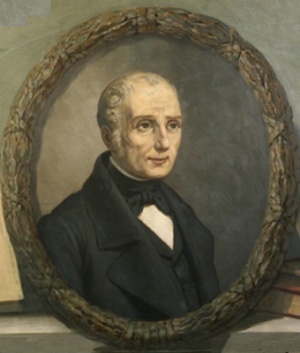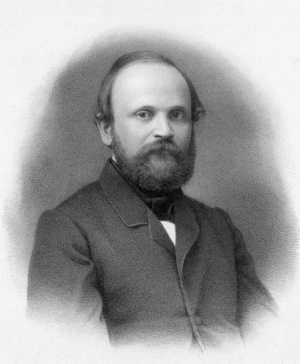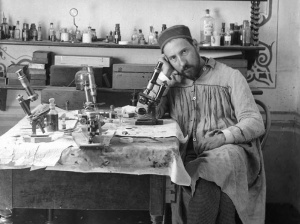Book - A History of Science 20
| Embryology - 27 Apr 2024 |
|---|
| Google Translate - select your language from the list shown below (this will open a new external page) |
|
العربية | català | 中文 | 中國傳統的 | français | Deutsche | עִברִית | हिंदी | bahasa Indonesia | italiano | 日本語 | 한국어 | မြန်မာ | Pilipino | Polskie | português | ਪੰਜਾਬੀ ਦੇ | Română | русский | Español | Swahili | Svensk | ไทย | Türkçe | اردو | ייִדיש | Tiếng Việt These external translations are automated and may not be accurate. (More? About Translations) |
Williams HS. A History of Science. (1904) Harper and Bros. New York.
| Historic Disclaimer - information about historic embryology pages |
|---|
| Pages where the terms "Historic" (textbooks, papers, people, recommendations) appear on this site, and sections within pages where this disclaimer appears, indicate that the content and scientific understanding are specific to the time of publication. This means that while some scientific descriptions are still accurate, the terminology and interpretation of the developmental mechanisms reflect the understanding at the time of original publication and those of the preceding periods, these terms, interpretations and recommendations may not reflect our current scientific understanding. (More? Embryology History | Historic Embryology Papers) |
Brain Structure
The common ground of all these various lines of investigations of pathologist, anatomist, physiologist, physicist, and psychologist is, clearly, the central nervous system--the spinal cord and the brain. The importance of these structures as the foci of nervous and mental activities has been recognized more and more with each new accretion of knowledge, and the efforts to fathom the secrets of their intimate structure has been unceasing. For the earlier students, only the crude methods of gross dissections and microscopical inspection were available. These could reveal something, but of course the inner secrets were for the keener insight of the microscopist alone. And even for him the task of investigation was far from facile, for the central nervous tissues are the most delicate and fragile, and on many accounts the most difficult of manipulation of any in the body.
Special methods, therefore, were needed for this essay, and brain histology has progressed by fitful impulses, each forward jet marking the introduction of some ingenious improvement of mechanical technique, which placed a new weapon in the hands of the investigators.
Rolando
The very beginning was made in 1824 by Rolando, who first thought of cutting chemically hardened pieces of brain tissues into thin sections for microscopical examination--the basal structure upon which almost all the later advances have been conducted. Muller presently discovered that bichromate of potassium in solution makes the best of fluids for the preliminary preservation and hardening of the tissues. Stilling, in 1842, perfected the method by introducing the custom of cutting a series of consecutive sections of the same tissue, in order to trace nerve tracts and establish spacial relations. Then from time to time mechanical ingenuity added fresh details of improvement. It was found that pieces of hardened tissue of extreme delicacy can be made better subject to manipulation by being impregnated with collodion or celloidine and embedded in paraffine. Latterly it has become usual to cut sections also from fresh tissues, unchanged by chemicals, by freezing them suddenly with vaporized ether or, better, carbonic acid. By these methods, and with the aid of perfected microtomes, the worker of recent periods avails himself of sections of brain tissues of a tenuousness which the early investigators could not approach.
Remak
But more important even than the cutting of thin sections is the process of making the different parts of the section visible, one tissue differentiated from another. The thin section, as the early workers examined it, was practically colorless, and even the crudest details of its structure were made out with extreme difficulty. Remak did, indeed, manage to discover that the brain tissue is cellular, as early as 1833, and Ehrenberg in the same year saw that it is also fibrillar, but beyond this no great advance was made until 1858, when a sudden impulse was received from a new process introduced by Gerlach. The process itself was most simple, consisting essentially of nothing more than the treatment of a microscopical section with a solution of carmine. But the result was wonderful, for when such a section was placed under the lens it no longer appeared homogeneous. Sprinkled through its substance were seen irregular bodies that had taken on a beautiful color, while the matrix in which they were embedded remained unstained. In a word, the central nerve cell had sprung suddenly into clear view.
A most interesting body it proved, this nerve cell, or ganglion cell, as it came to be called. It was seen to be exceedingly minute in size, requiring high powers of the microscope to make it visible. It exists in almost infinite numbers, not, however, scattered at random through the brain and spinal cord. On the contrary, it is confined to those portions of the central nervous masses which to the naked eye appear gray in color, being altogether wanting in the white substance which makes up the chief mass of the brain. Even in the gray matter, though sometimes thickly distributed, the ganglion cells are never in actual contact one with another; they always lie embedded in intercellular tissues, which came to be known, following Virchow, as the neuroglia.
Each ganglion cell was seen to be irregular in contour, and to have jutting out from it two sets of minute fibres, one set relatively short, indefinitely numerous, and branching in every direction; the other set limited in number, sometimes even single, and starting out directly from the cell as if bent on a longer journey. The numerous filaments came to be known as protoplasmic processes; the other fibre was named, after its discoverer, the axis cylinder of Deiters. It was a natural inference, though not clearly demonstrable in the sections, that these filamentous processes are the connecting links between the different nerve cells and also the channels of communication between nerve cells and the periphery of the body. The white substance of brain and cord, apparently, is made up of such connecting fibres, thus bringing the different ganglion cells everywhere into communication one with another.
In the attempt to trace the connecting nerve tracts through this white substance by either macroscopical or microscopical methods, most important aid is given by a method originated by Waller in 1852. Earlier than that, in 1839, Nasse had discovered that a severed nerve cord degenerates in its peripheral portions. Waller discovered that every nerve fibre, sensory or motor, has a nerve cell to or from which it leads, which dominates its nutrition, so that it can only retain its vitality while its connection with that cell is intact. Such cells he named trophic centres. Certain cells of the anterior part of the spinal cord, for example, are the trophic centres of the spinal motor nerves. Other trophic centres, governing nerve tracts in the spinal cord itself, are in the various regions of the brain. It occurred to Waller that by destroying such centres, or by severing the connection at various regions between a nervous tract and its trophic centre, sharply defined tracts could be made to degenerate, and their location could subsequently be accurately defined, as the degenerated tissues take on a changed aspect, both to macroscopical and microscopical observation. Recognition of this principle thus gave the experimenter a new weapon of great efficiency in tracing nervous connections. Moreover, the same principle has wide application in case of the human subject in disease, such as the lesion of nerve tracts or the destruction of centres by localized tumors, by embolisms, or by traumatisms.
All these various methods of anatomical examination combine to make the conclusion almost unavoidable that the central ganglion cells are the veritable "centres" of nervous activity to which so many other lines of research have pointed. The conclusion was strengthened by experiments of the students of motor localization, which showed that the veritable centres of their discovery lie, demonstrably, in the gray cortex of the brain, not in the white matter. But the full proof came from pathology. At the hands of a multitude of observers it was shown that in certain well-known diseases of the spinal cord, with resulting paralysis, it is the ganglion cells themselves that are found to be destroyed. Similarly, in the case of sufferers from chronic insanities, with marked dementia, the ganglion cells of the cortex of the brain are found to have undergone degeneration. The brains of paretics in particular show such degeneration, in striking correspondence with their mental decadence. The position of the ganglion cell as the ultimate centre of nervous activities was thus placed beyond dispute.
Gerlach
Meantime, general acceptance being given the histological scheme of Gerlach, according to which the mass of the white substance of the brain is a mesh-work of intercellular fibrils, a proximal idea seemed attainable of the way in which the ganglionic activities are correlated, and, through association, built up, so to speak, into the higher mental processes. Such a conception accorded beautifully with the ideas of the associationists, who had now become dominant in psychology. But one standing puzzle attended this otherwise satisfactory correlation of anatomical observations and psychic analyses. It was this: Since, according to the histologist, the intercellular fibres, along which impulses are conveyed, connect each brain cell, directly or indirectly, with every other brain cell in an endless mesh-work, how is it possible that various sets of cells may at times be shut off from one another? Such isolation must take place, for all normal ideation depends for its integrity quite as much upon the shutting-out of the great mass of associations as upon the inclusion of certain other associations. For example, a student in solving a mathematical problem must for the moment become quite oblivious to the special associations that have to do with geography, natural history, and the like. But does histology give any clew to the way in which such isolation may be effected?
Attempts were made to find an answer through consideration of the very peculiar character of the blood-supply in the brain. Here, as nowhere else, the terminal twigs of the arteries are arranged in closed systems, not anastomosing freely with neighboring systems. Clearly, then, a restricted area of the brain may, through the controlling influence of the vasomotor nerves, be flushed with arterial blood while neighboring parts remain relatively anaemic. And since vital activities unquestionably depend in part upon the supply of arterial blood, this peculiar arrangement of the vascular mechanism may very properly be supposed to aid in the localized activities of the central nervous ganglia. But this explanation left much to be desired--in particular when it is recalled that all higher intellection must in all probability involve multitudes of widely scattered centres.
Camille Golgi
No better explanation was forthcoming, however, until the year 1889, when of a sudden the mystery was cleared away by a fresh discovery. Not long before this the Italian histologist Dr. Camille Golgi had discovered a method of impregnating hardened brain tissues with a solution of nitrate of silver, with the result of staining the nerve cells and their processes almost infinitely better than was possible by the methods of Gerlach, or by any of the multiform methods that other workers had introduced. Now for the first time it became possible to trace the cellular prolongations definitely to their termini, for the finer fibrils had not been rendered visible by any previous method of treatment. Golgi himself proved that the set of fibrils known as protoplasmic prolongations terminate by free extremities, and have no direct connection with any cell save the one from which they spring. He showed also that the axis cylinders give off multitudes of lateral branches not hitherto suspected. But here he paused, missing the real import of the discovery of which he was hard on the track. It remained for the Spanish histologist Dr. S. Ramon y Cajal to follow up the investigation by means of an improved application of Golgi's method of staining, and to demonstrate that the axis cylinders, together with all their collateral branches, though sometimes extending to a great distance, yet finally terminate, like the other cell prolongations, in arborescent fibrils having free extremities. In a word, it was shown that each central nerve cell, with its fibrillar offshoots, is an isolated entity. Instead of being in physical connection with a multitude of other nerve cells, it has no direct physical connection with any other nerve cell whatever.
Ramon y Cajal
When Dr. Cajal announced his discovery, in 1889, his revolutionary claims not unnaturally amazed the mass of histologists. There were some few of them, however, who were not quite unprepared for the revelation; in particular His, who had half suspected the independence of the cells, because they seemed to develop from dissociated centres; and Forel, who based a similar suspicion on the fact that he had never been able actually to trace a fibre from one cell to another. These observers then came readily to repeat Cajal's experiments. So also did the veteran histologist Kolliker, and soon afterwards all the leaders everywhere. The result was a practically unanimous confirmation of the Spanish histologist's claims, and within a few months after his announcements the old theory of union of nerve cells into an endless mesh-work was completely discarded, and the theory of isolated nerve elements--the theory of neurons, as it came to be called--was fully established in its place.
As to how these isolated nerve cells functionate, Dr. Cajal gave the clew from the very first, and his explanation has met with universal approval.
In the modified view, the nerve cell retains its old position as the storehouse of nervous energy. Each of the filaments jutting out from the cell is held, as before, to be indeed a transmitter of impulses, but a transmitter that operates intermittently, like a telephone wire that is not always "connected," and, like that wire, the nerve fibril operates by contact and not by continuity. Under proper stimulation the ends of the fibrils reach out, come in contact with other end fibrils of other cells, and conduct their destined impulse. Again they retract, and communication ceases for the time between those particular cells. Meantime, by a different arrangement of the various conductors, different sets of cells are placed in communication, different associations of nervous impulses induced, different trains of thought engendered. Each fibril when retracted becomes a non-conductor, but when extended and in contact with another fibril, or with the body of another cell, it conducts its message as readily as a continuous filament could do--precisely as in the case of an electric wire.
This conception, founded on a most tangible anatomical basis, enables us to answer the question as to how ideas are isolated, and also, as Dr. Cajal points out, throws new light on many other mental processes. One can imagine, for example, by keeping in mind the flexible nerve prolongations, how new trains of thought may be engendered through novel associations of cells; how facility of thought or of action in certain directions is acquired through the habitual making of certain nerve-cell connections; how certain bits of knowledge may escape our memory and refuse to be found for a time because of a temporary incapacity of the nerve cells to make the proper connections, and so on indefinitely.
If one likens each nerve cell to a central telephone office, each of its filamentous prolongations to a telephone wire, one can imagine a striking analogy between the modus operandi of nervous processes and of the telephone system. The utility of new connections at the central office, the uselessness of the mechanism when the connections cannot be made, the "wires in use" that retard your message, perhaps even the crossing of wires, bringing you a jangle of sounds far different from what you desire--all these and a multiplicity of other things that will suggest themselves to every user of the telephone may be imagined as being almost ludicrously paralleled in the operations of the nervous mechanism. And that parallel, startling as it may seem, is not a mere futile imagining. It is sustained and rendered plausible by a sound substratum of knowledge of the anatomical conditions under which the central nervous mechanism exists, and in default of which, as pathology demonstrates with no less certitude, its functionings are futile to produce the normal manifestations of higher intellection.
Next

|
This is the last section in A History of Science (1904).
|
| Historic Disclaimer - information about historic embryology pages |
|---|
| Pages where the terms "Historic" (textbooks, papers, people, recommendations) appear on this site, and sections within pages where this disclaimer appears, indicate that the content and scientific understanding are specific to the time of publication. This means that while some scientific descriptions are still accurate, the terminology and interpretation of the developmental mechanisms reflect the understanding at the time of original publication and those of the preceding periods, these terms, interpretations and recommendations may not reflect our current scientific understanding. (More? Embryology History | Historic Embryology Papers) |
Glossary Links
- Glossary: A | B | C | D | E | F | G | H | I | J | K | L | M | N | O | P | Q | R | S | T | U | V | W | X | Y | Z | Numbers | Symbols | Term Link
Cite this page: Hill, M.A. (2024, April 27) Embryology Book - A History of Science 20. Retrieved from https://embryology.med.unsw.edu.au/embryology/index.php/Book_-_A_History_of_Science_20
- © Dr Mark Hill 2024, UNSW Embryology ISBN: 978 0 7334 2609 4 - UNSW CRICOS Provider Code No. 00098G





